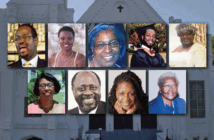Although congregations are prohibited from endorsing candidates or parties, Doug Powe and Ann Michel of the Lewis Center staff say there is much a church can do to encourage people to vote, ensure that voting occurs in a safe and secure manner, and encourage hope and civility in this polarized time.
Conducting a national election in the midst of a pandemic poses challenges for individual voters, local governments, and institutions serving as polling places. Even though congregations are prohibited from endorsing candidate or parties by virtue of their tax-exempt status, there is much a church can do to encourage people to vote and help ensure that voting occurs in a safe and secure manner. But most importantly, as election day approaches, the church can be a beacon of hope and model civility in these fraught and fractious times.
1. Encouraging voting
While some see faith and politics as two separate realms, for many Christians voting is a way to express their values and, in some cases, advance their missional concerns. There is no prohibition against churches conducting nonpartisan voter registration drives or participating in get-out-the-vote campaigns. Even in the midst of COVID-19, churches can educate their congregants about online voter registration (in jurisdictions where it is available) or host drive-thru voter registration events. Make sure you are familiar with registration options and deadlines in your area. And consider partnering with a nonpartisan civic organization such as the League of Women Voters or with another congregation to increase the volunteer pool during this challenging time when many are staying at home and volunteer numbers are lower.
2. Educating people about ways to vote
Due to COVID-19 concerns, many voters want to avoid visiting a crowded polling place on November 3, and many jurisdictions are offering expanded early voting or vote-by-mail options. But with these changes, there is also confusion and concern about how to vote safely and making sure every vote counts. Congregations can help their congregants plan their vote by sharing information about the time and location of early voting, the process for requesting a mail-in or absentee ballot, and the relevant deadlines. The National Association of Secretaries of State maintains a website where voters can check their registration status, find their polling place, and learn about absentee and early voting options.
Congregations can educate voters on polling places open for in-person voting this election cycle with a link on their website and by sharing information on various media platforms. If a congregation really wants to go the extra mile, it could act as an information center on election day and coordinate rides (using safety measures) for those who need transportation because their usual polling place is closed.
3. Sharing information on issues and candidate positions
While churches are prohibited from expressing support for or opposition to candidates or making contributions to candidates, churches can educate their members about key issues at stake in the election, discuss public policy, prepare and distribute nonpartisan voter guides, or sponsor candidate forums and debates. The United Church of Christ makes available online a Guidelines for Congregations on Political Action that outlines permissible and impermissible activities.
4. Offering hospitality at polling places
Under normal circumstances, churches host a third to half of the polling places across America. For congregations that are voting sites, the steady stream of people coming into a church building on election day can be an outreach opportunity and a chance to show their church off to its best advantage. Some churches set up hospitality stations and offer coffee and refreshments to voters standing in line. Others open their sanctuaries to those who wish to pray.
This year, for a variety of pandemic-related reasons, fewer congregations will be serving as voting sites. And those still hosting voting will be operating under social distancing requirements and other COVID-related restrictions. Yet, congregations can still welcome their neighbors in safe and appropriate ways, perhaps posting welcome signs, having “greeters” at a safe distance to help voters find parking or direct them into the building, or perhaps setting up a station with bottled water, packaged snacks, and coloring books or activity packets for children. Having drop-off stations or reserved parking for the elderly in some instances may be helpful, or having volunteers to hold an elderly voter’s place in line so they do not have to stand for long periods.
5. Promoting hope and healing
While passions run high in every major election cycle, this year the political climate is particularly fractious and fraught. In our increasingly polarized culture, a congregation can be one of the few places where people with differing political view still come together. Congregations should seek to model civility and respectful dialogue while also helping people see their fears and anxieties in the larger context of God’s enduring promises.
Congregations have a unique opportunity of bringing people together who would not normally connect. The way we model loving our neighbor can leave a lasting impression in a polarized community. Living into this calling means the outcome of the election takes a backseat to the calling of the church to spread God’s love abroad.
Regardless of the outcome of the election, we are in the midst of challenging times. But God is still among us, and Christ still calls us to follow him across turbulent water.
Related Resources
- “Faith and Public Life,” a Leading Ideas Talks podcast episode featuring Mike McCurry
- What Does Religious Freedom Mean Today? by Lovett H. Weems Jr.
- Leading between Faith and Patriotism by Lovett H. Weems Jr.






